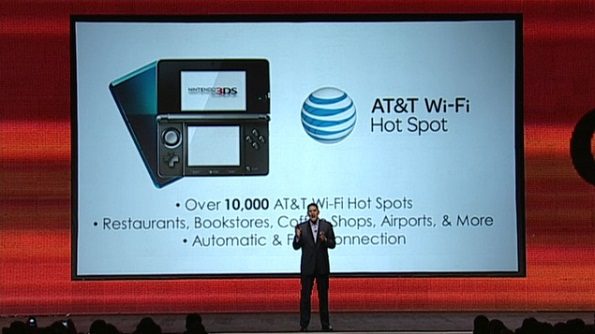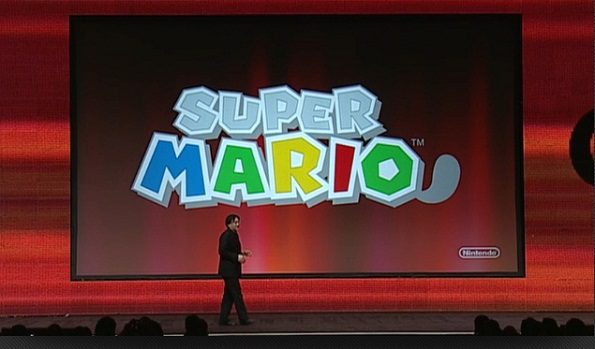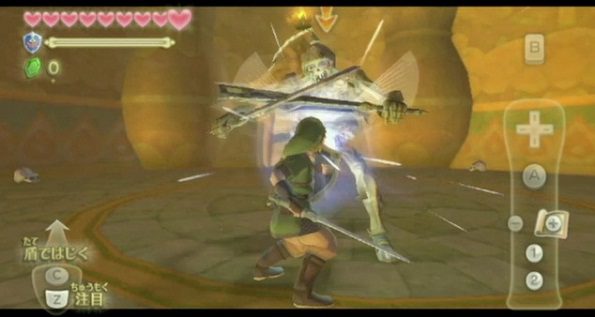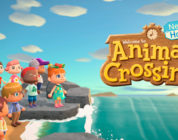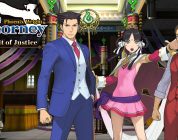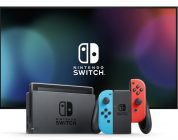Minutes ago Satoru Iwata, President and CEO of Nintendo, just gave an incredible keynote speech at GDC. Not only did he discuss the past 25 years of gaming, but he touched on what is going on in the industry today. Things kicked off when Meggan Scavio, Director of GDC, came out and said a few words before introducing Iwata-san.
During Scavio’s brief moment on stage, she took the time to send birthday wishes to Gordon Walton, VP and Executive Producer at PlayDom, who has attended all 25 GDC’s. Scavio also touched upon Iwata-san’s history at GDC as a keynote speaker, and when Iwata-san hit the stage you could tell that he was excited to be there.
In his opening, Iwata-san professed how he was excited about the chance to speak to colleagues, and that “the body of GDC is that all developers can learn from each other,” noting that “Nintendo is no exception.” As he started to go into the meat of his speech, Iwata-san brought up something that is true: content is king. The primary need, when developing a good game, is content. “Without quality content, without the imagination of everyone in this room today, there is nothing. There is no industry.” He went on to say that the developers are the center of the video game universe.
Looking back over the past 25 years, Iwata-san said it was shocking for him to realize that he’s worked as a developer all that time. Back in his 2005 keynote speech he discussed how he began working on games while he was still a college student. With some friends he formed Hal Laboratory and taught himself video game programming. When he started to work at Nintendo he was confident that he was better than anybody else who was working there as a programmer, and also thought that his skills would show when people went out to buy the game he was working on. At the same time Shigeru Miyamoto released a game and it outsold Iwata’s by a huge margin. It was a painful lesson to learn and Iwata-san said, “to be honest, I was ashamed.”
Back in those days, when video games began, there was no industry and it seemed like more of a hobby rather than a profession. There were times where it was hard to define what the roles were since most people would take turns doing what needed to be done. On the screen behind Iwata-san an image popped up with the words ” Which Hat Should I Wear Today?” Some days he would be a game designer, or an artist, a sound engineer, or other things. Even though they had a lot of fun back then, there were definite downsides. They barely made any money and that, compared to todays gaming standards, they were primitive like video game cavemen.
Over the years many things have changed. Iwata-san noted that even though graphics have gone up along with the amounts of memory that have helped expand game words, it all comes at a cost. Teams are much larger, the time lines and amount of money to fund it all has gone through the roof, and, at one time, development costs over $1 million was unthinkable. Nowadays gamers are demanding titles that take over $50 million to pull off. Fortunately for development studios a growth in the amount of gamers out there has helped offset costs. Nintendo wanted to measure how big the growth was because, even though they know how many consoles have sold, it doesn’t show how many people share a console or who the gamers are.
Since May of 2005, Nintendo has been conducting large scale surveys twice a year. They started in Japan but then were brought to Europe and the United States. Here in America, Nintendo worked with an independent company that surveyed individuals that ranged from age 6 to 74. In those findings they saw a large growth over the past few years, especially in female gamers, and the graphs that appeared behind Iwata-san showed everyone how things have rapidly changed. Over in Europe they took the surveys from 6 countries like the United Kingdom, Italy, and France. While the numbers are smaller than those of the U.S., Iwata-san says that it means there are more opportunities in Europe for growth, and that it should be encouraging for everybody.
Iwata-san’s speech started to shift a bit when he brought up social networking and the difference between that and social games. According to him, they are two different things. When one hears the term social network it means that there is a connection between people through various devices like computers or cell phones. Obviously video games can provide the same experience but it’s different. He then referenced back to an early computer game that came out in 1962 called Space War. It was the first to offer head-to-head competition, and by the 70’s people were playing on connected networks with computers even though the games at the time were only text based. Despite the absence of graphics, people were still having fun. The Atari 2600 launched in the United States back in 1977 and two controllers were included. Around that same time Nintendo released TV Game 6 in Japan and did the same. Flash forward to when the Nintendo 64 was released, everything changed again when they included 4 ports. Games like Mario Kart 64, GoldenEye, and Smash Bro’s all helped take everything to a new level.
Prior to that the Game Boy cable helped people play Tetris head-to-head, and back in those days being social only meant competing. When Pokémon came out for the original Game Boy, that ended up being another game changer. With Fire Red and Leaf Green, two editions that came out for the Game Boy Advance, changed the way the communication system worked and then it became the norm. Iwata-san was quick to point out that he doesn’t want to make it seem that Nintendo is taking too much credit for the social aspect and development of gaming, and went on to mention how Call of Duty is an online phenomenon and that Microsoft should be commended for their Xbox Live service.
Shifting gears again, Iwata-san brought up how over here in America we have this term, “must-have.” He said that it describe something so compelling that every passionate gamer immediately wants it, and that if you don’t you feel like you’ve been left behind. He then went on to say that must-have describes new experiences and that they tend to come from three sources. First was the Game Boy and how it provided those feelings because numerous games could be carried around by the owner wherever they went, but creating must-have tech only with technology isn’t easy. The second source is when there are times where a game itself is a must-have, but in Iwata-san’s eyes that doesn’t apply to just one particular game or genre. Games like Sonic and Just Dance flashed in the background. The third source comes from the player themselves. That’s where the social appeal of gaming comes in; the way players enjoy connecting remotely or in person. Iwata-san said that he found it remarkable that after all these years, 12 million people still subscribe to World of Warcraft.
Going back to development costs and ways to offset them, Iwata-san took a look at franchises that players have made popular over the past 25 years and highlighted their reasons for mass appeal. At the top of the list was Mario, a character we have all grown to love. Iwata-san said that it was hard to believe now that during Mario’s debut he was considered something brand new. As the excitement for Mario grew by word of mouth, Mario remained popular because of one thing: he has changed over the years. The developers behind the Mario games understood the need to provide gamers with new gameplay elements and because of that Mario will continue to evolve. Second on the list was Pokémon. By allowing gamers to collect, train, compete, and even trade Pokéemon has gone on to be a world-wide phenomenon. Certain Pokémon only appear in certain versions of the game, but players can also receive some from their friends versions. Unique aspects were designed to promote such interaction and obviously they were well received. Third was the aforementioned Tetris, the first video game to attract a female audience in a meaningful way. Even though the Game Boy was available in the United States for five months after the launch year in 1989, it was a massive hit. By December, 45% of Game Boy players were female. Last on his list was The Sims, the ridiculously popular simulation game from EA. Back when it came out many said that it wasn’t an actual game because there was no way to win or lose, however it has gone on to sell 125 million copies around the world.
Speaking to all of the developers in the room, Iwata-san said that there were valuable lessons to learn from these top sellers. Those lessons are: constant improvement, the power of socially connected players with each other, expanding gameplay to a new audience, and challenging existing notions of what is a game and how it should be played. On top of all of that, universal appeal, something that is desired but not easy to achieve, was mentioned. We were then told a story about how Kirby came to be. In one version of the game that Iwata-san worked on, it didn’t sell well. He took the build to Miyamoto-san and some changes were made. One big one was the overall design of the game, making it so that anybody could beat it but with a bit of patience. That strategy went completely against everything that gaming was about back then. Another change was the name, because if one translated the original one into English they’d get Tinkle Popo, not exactly something that would appeal to the Western market The final big change was what Kirby looked like on the cover of Kirby’s Dream Land. Some people thought that us Westerners would want to buy something that had a big, pink object that floated in the sky so Kirby was changed to white. Because they constantly considered the mechanics of the game, it has sold over 5 million copies. Another thing Iwata-san pointed out was that the process of developing a game is the same for everyone, and that at Nintendo things are just as stressful and just as difficult. “If there is a way to make it easy, we haven’t discovered it yet,” he said.
In terms of the future, Iwata-san did have some ideas for the must-have culture. He hopes that people decide that the next must-have is the 3DS, and when saying such he pulled one out of his pocket. Because it has the chance to attract mass-market attention because of technology, new gameplay, new ways players can socially interact, one can achieve the universal appeal and power to bring in new gamers. It was at this point in the keynote where we were given more details about the 3Ds like how all systems will come pre-installed with Face Raiders, AR Games, and Mii Maker – all games chosen to compel social interaction. Their ultimate goal is making people want to say to their friends, “hey, you have to see this.” Iwata-san hopes that people carry the handheld around so that they can see what new content comes to their device. At the Nintendo offices in Japan employees have been doing that, and while Iwata-san would normally send out an internal memo telling them not to do so, he said that he was doing it too. He went on to say that WiiWare and DSiWare services haven’t operated as they should, and that Nintendo can do better. To usher in Nintendo details for America, Iwata-san introduced Reggie Fils-Amie, President of Nintendo of America.
Reggie began his portion of the keynote by saying that the primary function of the 3DS is to play games. The range of connectivity is distinctive and that content can be captured, downloaded, and displayed all in 3D. It’s something you won’t find anywhere else. Another big thing is that all of the content on the 3DS isn’t going to look like anything that Nintendo has previously come out with, even when the device is used in 2D. At that moment Reggie announced Netflix for the 3Ds which will be available this summer. With Netflix on 3Ds a person can be watching a movie or a show on the road, but if they get home before it’s completed, they can pause it and switch to Netflix on their Wii console to resume. Reggie also brought up another scenario where if a family as a child that is watching Spongebob on Netflix and the parent wants to use the TV to play a game or watch something, they can pause the show and have the child right there with them while enjoying Spongebob on the 3DS.
3D movie trailers will also be coming to the device, starting with Green Lantern that comes out this June. Those attending GDC will be able to see other examples at the Nintendo booth. Reggie says that, with this feature, they are offering studios a distribution vehicle for them to reach a wider audience, and the ability to show trailers in 3D without glasses. In addition to that he announced that a short-form video service will be coming soon. A special wireless Nintendo channel will be available on the 3DS that will include comedy clips, music videos, and other stuff handpicked by Nintendo for gamers to enjoy. Even though the world is still in the beginning stages of content creation in 3D, Reggie says that at Nintendo they are investing to help accelerate that process, especially since people are excited about the 3D photo capabilities of the device. There was even a hint dropped about the ability to record video footage in 3D, but an update with more details will be coming soon.
As Reggie continued, we were told how Nintendogs and the recent Dragon Quest game led to StreetPass for the 3DS. With the SpotPass feature, which can only be accessed at Wi-Fi points, a lot of thought was put into it. In Japan they experimented widely with location-based community, and people would connect for free downloadable elements. They also found that if people would stop to sample a game, retail sales for the full game at nearby stores were as much as 6x higher than those at stores further away. In late May there will be over 10,000 AT&T hot spot hubs which will help maximize distribution opportunities for developers. With the new points of Wi-Fi contact users are automatically connected. Even if the device is in sleep mode or the game is absent, the content will still be loaded on.
A new shop, known as the Nintendo eShop, was discussed and shown. The DSiWare service will be included, but the Nintendo eShop will offer so much more. It will provide gamers with access to select Game Boy and Game Boy Color games, a 3DS version of a virtual arcade that will also include Game Gear and TurboGraphix 16 titles, and a section called 3D classic where favorite titles from the past will be fully remastered in 3D. In the eShop gamers will have access to new promotions, trailers, screenshots, background information about games, and even links to company websites. Nintendo hopes it will be come a one-stop-shop for unique and nostalgic game experiences, however not all of the features will be available out of the box. A worldwide system update will take place in late May that will include most of the features like allowing gamers to transfer their current DSi games to the 3DS, the web browser, and eShop. It was after that when Iwata-san came back to the stage and said that as people have a chance to witness the 3DS in person with their own eyes, he’s curious to see their reactions.
At this point the keynote was starting to near its close, but a few more things needed to be discussed, like a new Mario game for the 3DS. They want to develop new elements when introducing the next Mario game, and one thing is improving the jumping. When Super Mario 64 came out back in 1996, there was a problem with the jump design. As work on the 3DS began, Miyamoto-san said that they had solved the problem, and that a the same studio that worked on Super Mario Galaxy will be the ones behind this new title. A logo for the game flashed on the screen, and while it is temporary there was one thing people noticed; there was a Tanooki tail at the end of the O in Mario. Iwata-san teased us all by saying that during E3 this June they will reveal more. Next up was Legend of Zelda. With Ocarina of Time for the 3DS, they want the game to come out in June, but no official release date was given. Last year marked the 25th anniversary for Super Mario and this year is the 25th anniversary for Legend of Zelda. Miyamoto wants all Zelda lovers to celebrate together, and that led into a new video for Skyward Sword where more polished movements were shown.
Iwata-san also gave us his thoughts on the current state of the industry saying that “rather than offer us only a rosy picture of our industry, I want to discuss three specific concerns. First is craftsmanship. Over the past 25 years we developers have gained a lot but also lost something, and one major loss is craftsmanship. As projects become bigger and more complicated, working over and over to polish a game to make it the best it can be is not happening much anymore…no matter how much money or manpower is available, no matter how much talent is involved…small details can get lost even in huge projects. Second is talent development. Today there are many people who are better programmers than we were back then. They are artists, they are producers. This era of specialization makes it difficult for a single individual to sense the entire personality of a game. Developers know there are specific rules but are less able to understand anyone else’s. If people cannot tell what other team players are doing…where will the next master game creators come from?”
“When I first spoke at GDC in 2005 very few in the audience were involved in making games for mobile download and social networks. Today the majority of you are. Our industry has expanded but it gives me concern because I feel our business is dividing and is threatened,” he went on to say. “There has always been the ability to make a living. Will that still be the case moving forward? With so many choices it is difficult to gain enough visibility with consumers. A few games become mega-hits but it is not easy.” Iwata-san then said that the number of games to currently download are in the tens of thousands, and that nearly even one of them cost much cheaper to make than the console game, but how much money does it bring in? Throwing some numbers are way, Iwata-san shed more light on the subject by saying that 92% of the games are available for free, but those that changed from free are at extremely low prices. “Why is this happening?” he asked.
He continued by saying that over at Nintendo they see hardware as something people purchase to enjoy a game and that matching a games design with what hardware can offer is the best combination. They want their consumers to appreciate the premium value of software. “Although the PlayStation and Xbox businesses are different in some ways from Nintendo, I believe we all share this same idea 100%.” he added. Smartphones and social network platforms are the reasons those vehicles were created, and are not like those for consoles. Those platforms have no motivation to maintain a high value of gaming, and content is created by someone else. How they profit is through quantity. Noting that there are two distinct sides, Iwata-san said that “we should protect that value. It should be said that all is not lost. Games are diverse.”
Advice was then given on how one can get their game noticed, and the first thing Iwata-san mentioned was that the central element must be evident immediately because the initial sequence of a game is most important. “It must be quick and easy for people to describe the unique nature of your game to others. Social recommendations are far more persuasive than advertising. If both of these conditions are met you could reach the tipping point for world demand where your game begins to sell itself. That’s what we all want to achieve. There is a single solution to this challenge and it can be stated in a single word: innovation. There are many definitions though. At Nintendo we always ask ourselves the same question; is there something impossible that we can make possible?” One clear example was how it was originally thought that humans could only look at one screen at a time, but as technology evolved, and as people had more of this technology in their homes, it was found that people can watch TV, play around on a computer and/or use their tablet or cell at the same time. Since the Nintendo DS sold over 150 million units, clearly that original theory was proved wrong.
Iwata-san’s final words to those in attendance were those of encouragement, hope, and motivation. ” If the job of GDC is to learn from each other, I believe we can all learn from this. Trust your passion. Believe in your dream. Make the impossible possible. Why should we stop now?”



